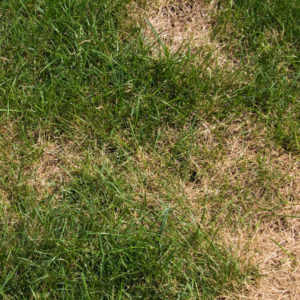
Learn how to spot common turf diseases like brown patch before they overtake your lawn.
Several fungal turf diseases can strike your lawn and wreak havoc. But how can you be sure you’re dealing with one of them? The first step is learning to identify turf diseases so you can seek treatment for your lawn as soon as possible. Active fungal disease typically appears during times of stress. Read on to learn how to identify some common turf diseases.
Brown Patch
This turf disease can affect almost any cool-season turf like tall fescue, Kentucky bluegrass, and perennial ryegrass. The disease first presents itself as a smoky looking ring of turf. As the disease progresses you’ll see circles of dead, sunken grass that can be as wide as three feet. Wet leaves, high humidity, over-fertilizing, and excess water can encourage the spread of brown patch disease. Fortunately, there are many treatments available for this disease.
Red Thread
Cool moist weather drives red thread and is especially likely to infest a lawn that lacks proper nutrients. It’s actually caused by a fungus and invades the lawn in two stages. First is the stage that gives this disease its name: thin, red, needle-like strands extending from the grass blades. From this stage the disease is spread via wind or even through contaminated equipment. The second stage brings the visible, pink, cotton-like spots that start as yellow or lighter green patches.
Dollar Spot
When this turf disease is present, you will notice silver-dollar size circles that spread up to 6 inches wide and gradually merge into large, irregular blocks. Your grass will develop straw-yellow spots that appear water-soaked. Individual lesions on the grass blades typically have an hourglass shape.
This disease often affects turf types, including fine fescue, perennial ryegrass, Kentucky bluegrass, tall fescue, Bermudagrass, and Zoysia grass. Under-fertilizing, excessive moisture, drought stress, and thatch can encourage dollar spot disease. This disease is best managed with preventive applications.
Pythium Blight
Pythium blight can occur quickly in vulnerable strands of turf, especially seedlings where it is known as damping off. Pythium outbreaks are associated with poorly drained soils or damp, humid conditions with little drying of the turf leaves. The symptoms of this disease include circular areas about 1-3 inches in diameter and foliage that develops a gray, water-soaked appearance. In the early morning the fungal mycelium can look like cotton Compacted soil, over-fertilizing, and overwatering can hasten the spread of Pythium blight.
Pink Snow Mold
This turf disease is more common in cold, wet conditions. Initial symptoms will include small circular patches that might consist of a water-soaked appearance around the edge. The patches become red-brown and then tan and bleached-looking under dry conditions. This disease affects tall and fine fescues most often. Poor drainage and too much shade can leave your grass vulnerable during the coldest months.
Summer Patch
This turf disease does most of its damage in the late spring and summer, but symptoms are typically not expressed until the turf is under more stress in late summer. You can identify this turf disease by spotting circles of dying and dead tan-colored grass with healthy-looking grasses in the center. Excessively high temperatures in late spring through summer can encourage disease development. Excess soil moisture, compacted soil, poor drainage, and low mowing make your turf extra vulnerable to summer patch.
While knowing how to identify common turf diseases is helpful, it is also beneficial to understand the best cultural practices that keep your lawn disease-resistant. The lawn care professionals at Scientific Plant Service can help you find the best care for your turf and determine your options if you spot signs of turf disease.
Scientific Plant Service Is Your Go-To Source In Landscape Healthcare
Scientific Plant Service, located in Baltimore, is a privately owned corporation, chartered in Maryland in 1957 by Frank J. Burke. We started as a full-service Arborists specializing in the care of shade trees and ornamental shrubs, but today we are a Lawn Care company that is a huge part of the community. From aquatic environments and snow management to deer and mole control, SPS has services tailored specifically for your lawn and landscape.
We offer services in Maryland, Washington, DC, and Virginia, including: Harford, Baltimore, Carroll, Frederick, Howard, Anne Arundel, Montgomery, Prince Georges, Talbot, Queen Anne’s, Calvert counties in MD, as well as Loudoun County, Fairfax County, Arlington, Alexandria, and Falls Church in VA. For more information, contact us online, or call us at 410-321-0970. Be sure to follow us on Facebook, Twitter, LinkedIn, and Pinterest.

